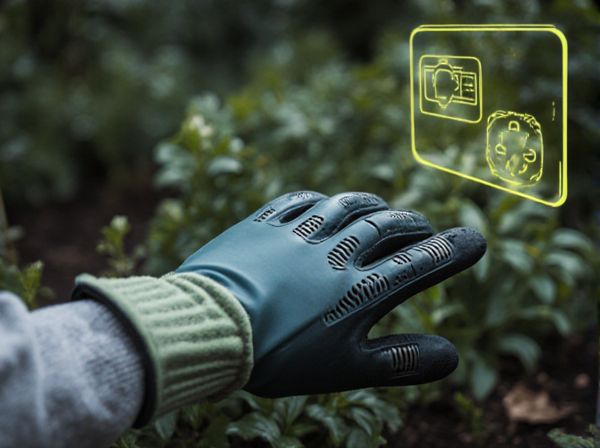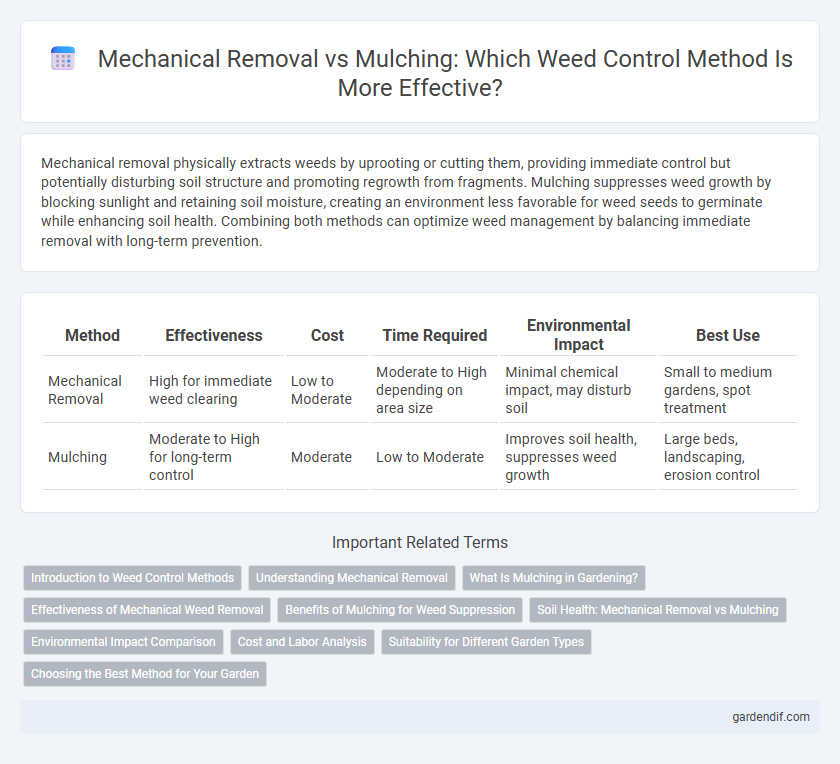
Mechanical removal vs mulching Illustration
Mechanical removal physically extracts weeds by uprooting or cutting them, providing immediate control but potentially disturbing soil structure and promoting regrowth from fragments. Mulching suppresses weed growth by blocking sunlight and retaining soil moisture, creating an environment less favorable for weed seeds to germinate while enhancing soil health. Combining both methods can optimize weed management by balancing immediate removal with long-term prevention.
Table of Comparison
| Method | Effectiveness | Cost | Time Required | Environmental Impact | Best Use |
|---|---|---|---|---|---|
| Mechanical Removal | High for immediate weed clearing | Low to Moderate | Moderate to High depending on area size | Minimal chemical impact, may disturb soil | Small to medium gardens, spot treatment |
| Mulching | Moderate to High for long-term control | Moderate | Low to Moderate | Improves soil health, suppresses weed growth | Large beds, landscaping, erosion control |
Introduction to Weed Control Methods
Mechanical removal and mulching are fundamental weed control methods that reduce competition for nutrients and sunlight. Mechanical removal involves physically uprooting weeds, which can be effective for small infestations but may cause soil disturbance leading to new weed growth. Mulching suppresses weed emergence by blocking light and maintaining soil moisture, enhancing soil health while minimizing the need for chemical herbicides.
Understanding Mechanical Removal
Mechanical removal of weeds involves physically uprooting or cutting unwanted plants, targeting their root systems to prevent regrowth and minimize reliance on chemical herbicides. This method is especially effective for managing invasive species and preventing seed dispersal in garden beds, agricultural fields, and landscaping areas. Proper timing and consistent application of mechanical tools like hoes, weeders, or tillers optimize weed control by disrupting growth cycles and reducing competition for nutrients and water.
What Is Mulching in Gardening?
Mulching in gardening involves applying a layer of organic or inorganic material on soil surfaces to suppress weed growth, conserve moisture, and regulate soil temperature. Common mulching materials include straw, wood chips, compost, and plastic sheeting, each offering specific benefits for plant health and soil quality. Mechanical removal uproots weeds directly, whereas mulching prevents weed seeds from germinating, providing a proactive, low-maintenance weed control strategy.
Effectiveness of Mechanical Weed Removal
Mechanical weed removal effectively reduces weed populations by physically uprooting or cutting unwanted plants, preventing seed production and inhibiting regrowth. Tools such as hoes, cultivators, and tillers disrupt weed roots and soil structure, limiting weed establishment and competition with crops. Unlike mulching, mechanical removal provides immediate weed control without relying on organic or synthetic barriers.
Benefits of Mulching for Weed Suppression
Mulching effectively suppresses weed growth by blocking sunlight, which inhibits weed seed germination and reduces the need for frequent mechanical removal. Organic mulches improve soil moisture retention and enhance microbial activity, promoting healthier crops while controlling weed competition. Compared to mechanical removal, mulching minimizes soil disturbance, reducing erosion and promoting long-term soil health.
Soil Health: Mechanical Removal vs Mulching
Mechanical removal of weeds disrupts soil structure by frequent tilling, increasing erosion risks and reducing beneficial microbial activity. Mulching enhances soil health by conserving moisture, regulating temperature, and promoting microbial diversity through organic matter decomposition. Choosing mulching supports long-term soil fertility and stability compared to mechanical weed control methods.
Environmental Impact Comparison
Mechanical removal of weeds minimizes chemical runoff and preserves soil health by physically extracting unwanted plants without disturbing surrounding ecosystems. Mulching suppresses weed growth by blocking sunlight, reduces soil erosion, and conserves moisture, enhancing soil quality and biodiversity. Both methods offer eco-friendly alternatives to herbicides, with mulching providing added benefits in organic matter enrichment and habitat for beneficial organisms.
Cost and Labor Analysis
Mechanical removal of weeds involves manual or machine-driven uprooting, often requiring significant labor hours and higher initial investment in equipment, making it cost-intensive for large areas. Mulching, using organic or synthetic materials, reduces labor by suppressing weed growth and maintains soil moisture, typically lowering ongoing maintenance expenses. Cost analysis shows mulching offers long-term savings despite higher upfront material costs, whereas mechanical removal demands continuous labor input, increasing overall expenditures over time.
Suitability for Different Garden Types
Mechanical removal is highly effective for vegetable gardens and small flower beds where precise weed elimination is necessary without disturbing surrounding plants. Mulching suits ornamental gardens and larger landscapes, providing extensive weed suppression while enhancing soil moisture retention and temperature regulation. Combining both methods can optimize weed control based on garden size, plant sensitivity, and maintenance goals.
Choosing the Best Method for Your Garden
Mechanical removal effectively eliminates weeds by uprooting them, preventing regrowth and is ideal for gardens with minimal plant density. Mulching suppresses weed growth by blocking sunlight, conserving soil moisture, and improving soil health, making it suitable for flower beds and vegetable gardens. Gardeners should assess plant types, weed species, and maintenance effort to choose between the immediate control of mechanical removal and the long-term benefits of mulching.
Mechanical removal vs mulching Infographic

 gardendif.com
gardendif.com